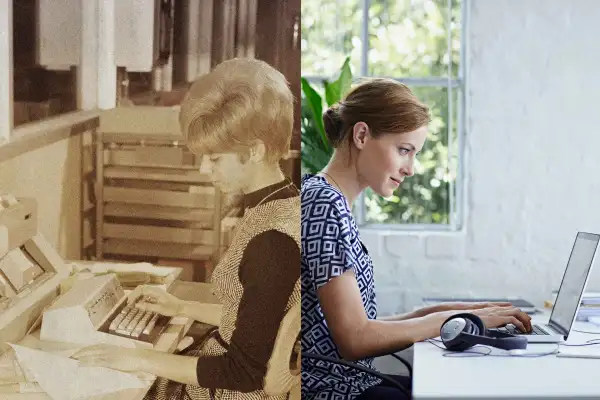From Half a Loaf to Three-Quarters: Here’s What (Hasn’t) Changed for Working Women in the Past 50 Years

We just launched Money Archives, a new experience where we're digitizing decades of our print Money magazines. This is the first in a series of Then and Now stories that examine how personal finance — and our coverage of it — has evolved over time.
Fifty years ago, women made up a third of the labor force in the United States — but they weren’t allowed to apply for credit cards, business loans or mortgages without their husbands’ consent (and signatures). Borrowing from an old proverb, a 1972 Money story declared that many “working wives” lived “half-a-loaf” lives, earning some money but bringing home nowhere near the amount they needed.
“Child care, discriminatory taxes and hidden expenses can devour 70% of a woman's contribution to family income,” we wrote at the time.
Five decades later, little has changed.
Women today make up more than half of the labor force in the U.S, but Randy Albelda, professor emerita of economics and senior research fellow at the Center for Social Policy at the University of Massachusetts Boston, says they still face “the same set of issues.”
“We haven’t caught up,” she says.
Women still earn less than men. Though every American’s situation is unique, Albelda says there are three main factors behind the gender pay gap.
One is what she calls the “care penalty,” or “this notion of having to shape your employment around taking care of children and others in the household.” Occupational differences, where women are funneled into jobs that pay less, are the second. And the third, of course, is discrimination — where outsiders think “you're not as good because you're a woman or you're not as good because you're a person of color. That kind of discrimination still exists,” Albelda says.
If we focus on numbers alone, we can see that in 1972, women earned about 56% less than men. In 2022, women still make about 21% less. (Check out the table below for more information.)
The salary gap between men and women is still widening, with men’s minimum salary expectations up to $24,000 higher than women's. July data from the Bureau of Labor Statistics points to the wage gap, too: Median weekly earnings for women total $943. For men, that figure is $1,144.
| Men’s median wages in 1972 (with a 4-year degree) | Women’s median wages in 1972 (with a 4-year degree) |
| $14,400 | $9,200 |
Data from “The Half-a-loaf Life of the Working Wife.”
| Men’s median wages in 2022 | Women’s median wages in 2022 |
| $54,912 | $45,264 |
Weekly earnings reported by the Bureau of Labor Statistics were multiplied by 52 to calculate median yearly wages.
Salary differences can have an immediate impact on women’s finances while also affecting their futures. If the average woman were able to invest all of her lost earnings over a 40-year career, she could earn up to $1.6 million more in retirement savings, according to data from the Center for American Progress.
“[Wage inequality] affects all women, but it affects them differently,” Albelda says. “For example, women of color face more wage discrimination, and that’s going to affect your whole life because you’ll have less to put into pensions, to invest in your kids and in yourself. That adds up and accumulates over time.”
Our 1972 writers could never have predicted the COVID-19 crisis, but when the pandemic forced a nationwide lockdown in 2020, the situation for women and caregivers became even more stressful. Families felt a physical and emotional toll that is almost unmeasurable — and that’s in addition to the financial consequences.
According to Child Care Aware of America, nearly 9,000 childcare centers closed in 37 states between December 2019 and March 2021, pressuring many working parents to juggle work and childcare. The circumstances led some mothers to lose out on wages, savings, retirement, health insurance and career growth opportunities.
“Mothers tend to shape their employment around caregiving, so even if they are employed, they may take a job that allows them some flexibility so they can make sure kids are where they're supposed to be,” Albelda says. “COVID-19 made us realize schools and childcare centers are important mechanisms that allow women to work.”
Women who didn’t or couldn’t leave the workforce had to deal with remote work — often while supervising their children attending remote school in the next room. This presented its own, still-evolving set of challenges. However, according to Albelda, remote work has, in some cases, provided an opportunity for women to recalibrate.
”It's been a double-edged sword, although I believe it has allowed people more time to do more of the things they need to do to help balance their work and family,” she says.
The rise of remote work, just like the gender wage gap, has affected everyone in different ways. There’s no one statistic that sums it up or one story that we can tell, especially with the vast range of genders in the U.S. today. But while some progress has been made, Albelda says there's still a long way to go towards income equality.
In 1972, many women may have experienced “half-a-loaf” lives.
Now, it’s a “three-quarters of a loaf or maybe two-thirds of a loaf,” she says, with a caveat: “The size of the loaves are different for different people. That's an important form of inequality, too.”
Visit Money Archives.


